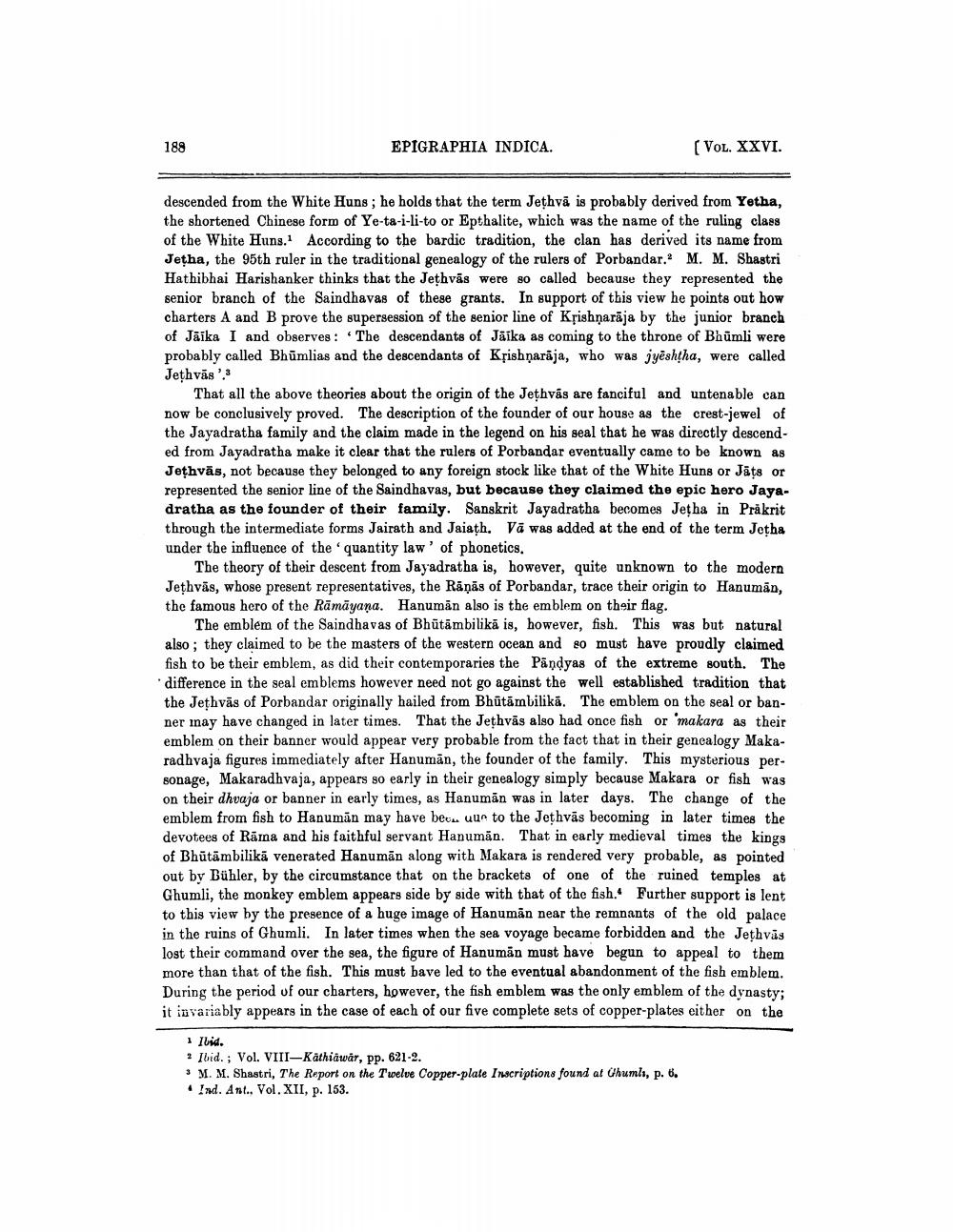________________
188
EPIGRAPHIA INDICA.
(Vol. XXVI.
descended from the White Huns; he holds that the term Jethvā is probably derived from Yetha, the shortened Chinese form of Ye-ta-i-li-to or Epthalite, which was the name of the ruling class of the White Huns. According to the bardic tradition, the clan has derived its name from Jetha, the 95th ruler in the traditional genealogy of the rulers of Porbandar. M. M. Shastri Hathibhai Harishanker thinks that the Jethvās were so called because they represented the senior branch of the Saindhavas of these grants. In support of this view he points out how charters A and B prove the supersession of the senior line of Krishnarāja by the junior branch of Jāika I and observes: The descendants of Jãika as coming to the throne of Bhümli were probably called Bhūmlias and the descendants of Kțishộarāja, who was jyēshtha, were called Jethvās '.3
That all the above theories about the origin of the Jethvás are fanciful and untenable can now be conclusively proved. The description of the founder of our house as the crest-jewel of the Jayadratha family and the claim made in the legend on his seal that he was directly descended from Jayadratha make it clear that the rulers of Porbandar eventually came to be known as Jethvās, not because they belonged to any foreign stock like that of the White Huns or Jāts or represented the senior line of the Saindhavas, but because they claimed the epic hero Jayadratha as the founder of their family. Sanskrit Jayadratha becomes Jetha in Prakrit through the intermediate forms Jairath and Jaiath. Vā was added at the end of the term Jetha under the influence of the quantity law' of phonetics.
The theory of their descent from Jayadratha is, however, quite unknown to the modern Jethvās, whose present representatives, the Rāņās of Porbandar, trace their origin to Hanuman, the famous hero of the Rāmāyana. Hanuman also is the emblem on their flag.
The emblem of the Saindhavas of Bhūtāmbilikā is, however, fish. This was but natural also; they claimed to be the masters of the western ocean and so must have proudly claimed fish to be their emblem, as did their contemporaries the Pāņdyas of the extreme south. The difference in the seal emblems however need not go against the well established tradition that the Jethvās of Porbandar originally hailed from Bhūtāmbilika. The emblem on the seal or banner may have changed in later times. That the Jethvās also had once fish or 'makara as their emblem on their banner would appear very probable from the fact that in their genealogy Makaradhvaja figures immediately after Hanumān, the founder of the family. This mysterious personage, Makaradhvaja, appears so early in their genealogy simply because Makara or fish was on their dhvaja or banner in early times, as Hanuman was in later days. The change of the emblem from fish to Hanumān may have been uur to the Jethvās becoming in later times the devotees of Rāma and his faithful servant Hanuman. That in early medieval times the kings of Bhūtāmbilikā venerated Hanumān along with Makara is rendered very probable, as pointed out by Bühler, by the circumstance that on the brackets of one of the ruined temples at Ghumli, the monkey emblem appears side by side with that of the fish. Further support is lent to this view by the presence of a huge image of Hanumān near the remnants of the old palace in the ruins of Ghumli. In later times when the sea voyage became forbidden and the Jethvas lost their command over the sea, the figure of Hanuman must have begun to appeal to them more than that of the fish. This must bave led to the eventual abandonment of the fish emblem. During the period of our charters, however, the fish emblem was the only emblem of the dynasty; it invariably appears in the case of each of our five complete sets of copper-plates either on the
i luid. ? Ibid. ; Vol. VIII-Kathiawar, pp. 621-2. 3 M. M. Shastri, The Report on the Twelve Copper-plate Inscriptions found at Chumli, p. 6.
Ind. Ant., Vol. XII, p. 153.




